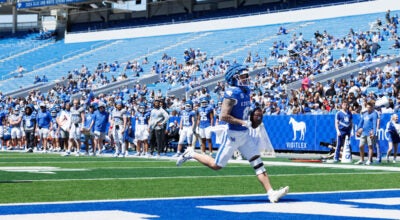Marching band classifications to change in Kentucky this school year
Published 4:59 pm Monday, July 29, 2019
By DAVID B. SNOW
The Paducah Sun
For years, the classification of marching bands — like the classification of high school football teams — was based on a school’s enrollment, but the Kentucky Music Education Association is introducing a new system of classification based in part on the number of band participants.
John Stroube, executive director of the KMEA, said that a committee of representatives from each of the 12 statewide districts determined that bands would be classified this fall based on a formula that included the number of performing musicians (excluding color guard, drum majors, etc.) and the enrollment size of the school.
“About half the weight of determining the classification is from the size of the band, using only the musicians to consider — woodwinds, brass and percussion, basically,” he said. “That hearkens back to pre-2005, in a fashion, because that was how that was done back then.”
For example, the Paducah Tilghman band was classified as 3A in 1993 and 1995-97, but was 1A in 1998, 2001 and 2003 and 2A in 1994, 1999, 2000, 2002 and 2004. It has been 3A since 2005. McCracken County has been 5A since beginning competition in 2015.
“Once all the schools have enrolled in the (KMEA) championship that are going to enroll, by Aug. 15 — that’s their deadline — then we know who we’re dealing with,” Stroube said. “We’ll know which bands are in and which bands have determined that they’re not going to do it.”
The enrolled bands will be divided into five equal groups based on school enrollment size. The schools in those five groups would then be sorted by band size into five more groups. Bands are then assigned points based on school and band size; the smaller groups would get fewer points than larger groups. Those points are tallied and the band classification is based on the point total. There will still be five classifications.
“Like everything, there’s pros and cons and complications,” Stroube said. “One of the complications is that people don’t know what class they’re in until Aug. 15, where previously, they’ve known in the spring of the year.
“It’s in hopes of leveling the playing field, as we always try to do and making it a little more fair for the outliers.”
Stroube said the band classifications would likely be changed each year, rather than be reviewed every four years, as the Kentucky High School Athletic Association does for its classified sports. He added that the district representatives would get feedback from band directors in their district and meet in November to discuss the new classification system.
“Nothing’s in stone,” he said. “I tend to think, too, that the first time you do something, you’ll probably change it before you do it again. The first time is the trial. I would be surprised if, next year, there isn’t something that improves it a little bit after we learn from experience.
“I think, all in all, the committee was persuaded that this would be more fair to more bands. That’s the underlying thing of what people are trying to do.”






